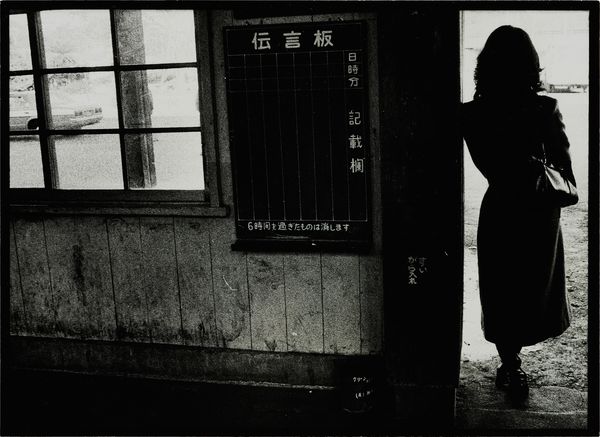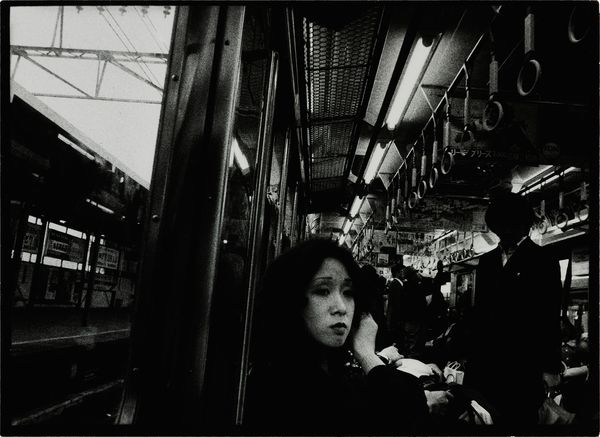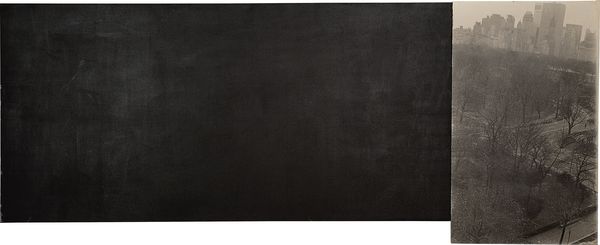Unique gelatin silver print from Ishiuchi Miyako 絶唱 、横須賀ストーリー Yokosuka Story, 1976-1977, a collection of 22 unique prints
Exclusively at Phillips London, ULTIMATE is a unique selection of photographs, photo-based works and video. In this first Evening edition, we have curated a tightly edited collection of 27 outstanding works, dating from the late 19th century to the present, and ranging from rare masterworks to exclusive collaborations.
Following up on our recent world auction records for Masahisa Fukase and Seiji Kurata, we continue our celebration of 1970s Japanese photography with exceptional works by Ishiuchi Miyako, Kunié Sugiura and Tamiko Nishimura, three women artists whose creative output can be described as highly subjective and deeply personal.
Ishiuchi Miyako
"Yokosuka was like a deeply haunting feeling of brutality, and onto hundreds of pure white photographic paper, I spewed it out in deep blacks," wrote artist Ishiuchi Miyako in Yokosuka Story, 1979.
In the autumn of 1976, Ishiuchi Miyako, a 29-year-old self-taught photographer, journeyed to her hometown of Yokosuka to photograph the port city where she had lived from the age of 6 until 19. Her thirteen years in Yokosuka — the site of the largest U.S. naval base overseas — were tainted by grim memories of World War II and tensions caused by a dominant U.S. presence. It was her lingering loathing of Yokosuka that led her to choose it as the subject of her first major project, and photography was her tool of self-expression with which she purged her unwanted feelings and dark memories of her hometown. Her debut Yokosuka Story was born of this act of expelling her inner turmoil.
I am photographing the city of Yokosuka, but actually, I am not photographing the city of Yokosuka.
— Ishiuchi Miyako
Unique gelatin silver print from Ishiuchi Miyako 絶唱 、横須賀ストーリー Yokosuka Story, 1976-1977, a collection of 22 unique prints
In Yokosuka Story, Ishiuchi presents a fictional Yokosuka rendered in black and white. Dark, grainy and off-kilter, her photographs are quietly unsettling. Juxtapositions of close-up and faraway views, straight and oblique angles, derelict buildings and solitary figures reflect the tensions she felt growing up in the turbulent base town. On completing her project in March of 1977, Ishiuchi showed 100 Yokosuka photographs to Nobuyoshi Araki, whose introduction to Jun Miki, photographer and director of Nikon Salon, resulted in her maiden solo show 絶唱、横須賀ストーリー Yokosuka Story from 26 April to 1 May at Nikon Salon in Ginza, Tokyo.
In 1978, Ishiuchi created the publishing company Shashin Tsūshinsha, financed with the three million yen her father had saved for her wedding, to self-publish her first two photobooks, which included Yokosuka Story. The following year, 1979, was historically significant for Ishiuchi who became the first woman to receive the Kimura Ihei Award, the most coveted photography award in Japan, and the only woman artist to be included in the group exhibition Japan: A Self-Portrait at the International Center of Photography in New York, which marked the first presentation of her work abroad. This was also the same year in which she created the present work as part of nearly 100 unique cabinet-card-sized prints of Yokosuka Story for a Nikon Salon exhibition in Paris that never took place. Thin black borders frame each small photograph, and together, the 22 images can be read as a narrative — Ishiuchi's own Yokosuka Story — woven with memories, experiences and histories.
One of Japan's leading artists, Ishiuchi represented Japan at the 2005 Venice Biennale and is a multiple award winner, including the 4th Kimura Ihei Award (1979), Japan's Medal with Purple Ribbon (2013) and the Hasselblad Award (2014). Her work has been exhibited internationally since 1979, and recent museum retrospectives include Ishiuchi Miyako: Postwar Shadows at the J. Paul Getty Museum, Los Angeles (2015-16) and Ishiuchi Miyako: Grain and Image at the Yokohama Museum of Art (2017-18). Her work is held in many prominent institutions, including the National Museum of Modern Art, Tokyo; Yokohama Museum of Art; Tokyo Photographic Art Museum; J. Paul Getty Museum, Los Angeles; San Francisco Museum of Modern Art; The Metropolitan Museum of Art, New York; Museum of Modern Art, New York; and Tate Modern, London, which holds 40 unique cabinet-card-sized prints from Yokosuka Story.
Kunié Sugiura
In this remarkable work by New York-based Japanese artist Kunié Sugiura, two canvases are assembled side by side: one, measuring 191 cm wide, is painted with black acrylic, and the other, measuring 102 cm high, is printed with a black-and-white photograph. As the title, View from Dakota, suggests, the vertical view of the northwest corner of Central Park West, seen from an elevated perspective, was taken from the Dakota—Manhattan's iconic co-operative building. Addressing the materiality of photographic emulsion in her work, Sugiura has combined photography and painting to create a unique visual experience.
New York was very essential to me; I couldn't think of being in another place. I appreciate the time I have spent here.
— Kunié Sugiura
Kunié Sugiura View from Dakota, 1979
During the 1960s, Sugiura studied at the School of the Art Institute of Chicago (SAIC) under Kenneth Josephson, who influenced her to become the only undergraduate in her class to major in photography. At a time when Andy Warhol and Robert Rauschenberg were creating silkscreens on canvas, Sugiura began printing photographs onto canvas, driven by a desire to equate photography with painting. After graduating from SAIC in 1967, Sugiura moved to New York, where she has lived and worked for the past five decades. Her work was first exhibited in 1972 in the Annual Exhibition of Contemporary American Painting at the Whitney Museum of American Art. As her creative process evolved, she discovered a new visual dynamic by arranging photographic images alongside monochrome paintings. In this body of work termed 'photo-painting', Sugiura created a synergy between the two media.
View from Dakota is among the largest of Sugiura's unique 'photo-paintings' and is her most significant work to be offered at auction. Sugiura has exhibited internationally and her work resides in many prominent institutions, including the Museum of Modern Art, New York; Museum of Fine Arts, Boston; National Museum of Modern Art, Tokyo; and Tate Modern, London. Her first major retrospective will be held at the Tokyo Photographic Art Museum from 24 July to 24 September 2018.
Tamiko Nishimura
This unique しきしまShikishima triptych by Tamiko Nishimura consists of three highly emotive photographs taken in 1970-71 during her travels in the Hokkaidō, Tōhoku and Hokuriku regions of Japan. Her longing to visit these faraway places began during her childhood in Tokyo and her fascination with pictures of snowy landscapes and matsuri [festivals] depicted on the postcards her father would send her from his frequent business trips. After graduating from Tokyo Photographic College (currently Tokyo Visual Arts College) in 1969, the 21-year-old Nishimura set off on her first of many journeys around Japan.
I think I've been drawn to what lies beyond the union of seer and seen, wanting to give shape to things that fall apart soon after they're photographed. Or perhaps it's the ineffable attraction to the unseen.
— Tamiko Nishimura
Tamiko Nishimura しきしま Shikishima, 1970-1971
The left image of empty railway tracks was taken in spring 1971 in Asahikawa, Hokkaidō, the northernmost of Japan's four main islands. Of this photograph, Nishimura remembers, "I was fascinated by the open landscape. Looking at the empty tracks, I imagined that the end of the line was Cape Sōya, the northernmost point of the island of Hokkaidō." The young woman in the center was taken in summer 1970 in Aomori prefecture in Tōhoku region of Northeast Japan. She recalls, "I was photographing while in a taxi using a telephoto lens. When the taxi stopped at a red light, a face of a woman standing on the pavement jumped into my frame and I pressed the shutter. It was a fleeting moment so this is the only shot." On the right is an almost abstract seascape taken in winter 1970 in Ishikawa prefecture in Hokuriku region of Northwest Japan. She visited the Uchinada sand dunes, where this image was shot, to see the relics of the ammunition storage facilities, which played a part in the 1952 'Uchinada Battle' and the ensuing anti-US military base campaign.
After her Hokkaidō trip in spring 1971, Nishimura returned to Tokyo where she printed the three large prints offered here. Using leftover photographic papers from her 1969 graduation exhibition, she printed her three most favorite images at the time, representing three separate journeys, and pinned them to her wall at home. The pinholes, which are visible in the corners of each print, reveal the history of these prints. In 1972, she received an unexpected call from her alma mater Tokyo Photographic College with an offer to publish her first photobook, which resulted in しきしまShikishima (1973), now a rare photobook. The title is an epithet used in classical Japanese Waka poetry for Yamato, the ancient name for Japan, and the book showcases her series of photographs taken in 1969-72 on her journeys around Japan's Hokkaidō, Tōhoku, Hokuriku, Kantō, Kansai and Chūgoku regions. Working on image selection, sequencing and editorial design, Nishimura self-produced Shikishima.
Nishimura's language of expression is poetic, spiritual and deeply personal, as discerned in this unique, early triptych. This is an unparalleled opportunity to acquire an important early work by Tamiko Nishimura, still relatively unknown outside of Japan, as the market for Japanese photography of the 1970s continues to unfold.



